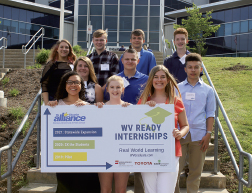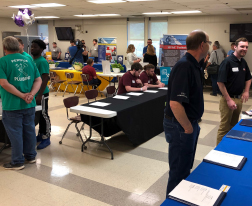Preparing West Virginia’s Future Workforce
By Olivia Miller
Creating a strong workforce with the capacity to support families and individuals alike in West Virginia for decades to come requires a collaborative effort that combines industry professionals, government officials and educators. West Virginia, like the rest of the country, faces a critical need for skilled workers. The world is rapidly changing, and the knowledge and skills that were imperative to building a vibrant economy in the past are different from those needed now. Today, three organizations in West Virginia are implementing and creating strategies to propel the workforce into prosperity and close the gap between skilled workers and employers.
West Virginia Ready

West Virginia youth in several counties throughout the southern part of the state are being presented with the opportunity to apply for paid, high-quality summer internships with some of the state’s leading employers through the West Virginia Ready internship program. The program, established by The Education Alliance and Leadership West Virginia, provides an avenue for high school students to explore career opportunities and improve their soft skills before graduating and entering the workforce or continuing their education.
“Although some college students may have opportunities to participate in internships, we believe this may be too late for many of West Virginia’s youth,” says Amelia Courts, president and CEO of The Education Alliance. “By exposing high school students to real jobs in some of the state’s leading industries such as manufacturing and health care, students learn about high-quality, high-paying jobs right here in the Mountain State. They also get excited as they try out different careers within those industries and find a pathway to align their dreams and talents.”
Toyota, Appalachian Power and Cabell Huntington Hospital served as the pilot businesses for the first year of the program, in which 10 students participated. In the future, The Education Alliance anticipates expanding the number of interns, employers and regions with the goal of eventually offering the program statewide.
High school juniors and seniors within driving distance of Putnam, Kanawha and Cabell counties are given the chance to apply and be hired by the companies. The students experience a four-week summer internship where they receive high-quality training and orientation, as well as weekly webinars focused on developing valuable soft skills. When they complete the internship, the participants are eligible to receive college credit.
“During their final presentations, interns consistently reported that their four-week internship experience was both eye opening and life changing. Numerous students mentioned that the experience had changed or solidified their career plans for the future,” says Courts. “The summer internship program allows the alliance to fill a niche that connects businesses directly with students in a meaningful way that benefits the student and the business partner and helps build the state’s human capital.”
Reintegrate Appalachia
The Appalachian region has suffered greatly from the opioid epidemic, and West Virginia has been one of the hardest-hit areas. According to Terry Danielson, the southern program manager of Reintegrate Appalachia, a nonprofit workforce development program designed specifically for those recovering from substance use disorder, a high percentage of West Virginia’s population suffers from this disorder, and the result is an extremely dislocated workforce.
The concept for Reintegrate Appalachia was created soon after Doug Leech, founder and CEO of Ascension Recovery Services, and Brandon Dennison, founder and CEO of Coalfield Development, met in 2016. A few years later, a funding opportunity presented itself, and in 2019, Reintegrate Appalachia was launched.
The program aims to re-engage individuals in early recovery in their community through meaningful employment, the opportunity to continue their education and grow their professional skills and the clinical and peer-to-peer support needed to maintain sobriety. An individual applies to the program after successfully completing a medically managed withdrawal and clinical stabilization treatment program.
“This program will provide that extra layer of support needed so the participant can reintegrate into the workforce and deal with the stress and frustration that comes with getting and holding a job,” says Danielson. “It also provides the monitoring that helps ease the minds of those who are giving the participants an opportunity to become employed again.”
Reintegrate Appalachia has had 43 participants since its inception, 23 of which are still active with the program and gainfully employed. Many participants find work in the hospitality field while others are working as laborers.
“Stigma has been a barrier for employment,” says Danielson. “Many of these individuals do not have a valid driver’s license or a vehicle, so transportation is a huge barrier, as are daycare needs.”
While the applicant can be from anywhere in the Appalachian region, the target counties are Braxton, McDowell, Monongalia and Wayne. In the future, Reintegrate Appalachia hopes to expand into other counties.
“We want to continue creating a fine-tuned model of what is working in the state of West Virginia concerning employment, education and training for individuals in early recovery,” he says.
Reverse Job Fairs

After identifying a disconnect between skilled high school graduates and employers in the state that are looking to hire workers, the West Virginia Department of Education (WVDE) partnered with Career Technical Education (CTE) centers across the state to host a series of Reverse Job Fairs. The goal was to connect employers with West Virginia’s emerging workforce: graduating CTE students who are drug-free, certified by industry recognized standards and seeking employment after graduation.
This spin on the traditional job fair gives students the opportunity to set up specific booths that showcase their technical skills and portfolios to participating employers looking to hire skilled workers. Throughout the eight fairs held in the first year of the program, 19 of West Virginia’s 55 counties participated, and the fairs brought in 239 business representatives from 133 unique companies.
“The success of the Reverse Job Fairs went beyond our expectations. Next year, many schools will be offering this opportunity for employers seeking highly skilled and drug-free workers,” says Associate State Superintendent of Schools Kathy D’Antoni. “West Virginia has phenomenal young people who would like to stay in West Virginia, work and raise their families. It is up to us to nurture, train, educate and retain them.”
Data from the National Skills Coalition shows that 57 percent of the state’s jobs are in middle-skill sectors and require education beyond high school but not necessarily a four-year degree. These jobs make up the majority of the nation’s workforce as well. D’Antoni explains that both nationally and statewide, key industries have a difficult time finding workers to fill these jobs, thus creating a skills gap. The primary focus of the WVDE’s CTEs is to address the demands of the state’s workforce.
According to D’Antoni, the atmosphere at the Reverse Job Fairs is exciting and electric. “Businesses were impressed by the quality and skill level of the students and amazed at the number of different programs being offered and the equipment students were being trained on,” she says.
The Reverse Job Fairs are an important step in bridging the communication gap between the employment opportunities and young people in West Virginia while also creating a vibrant economy.



